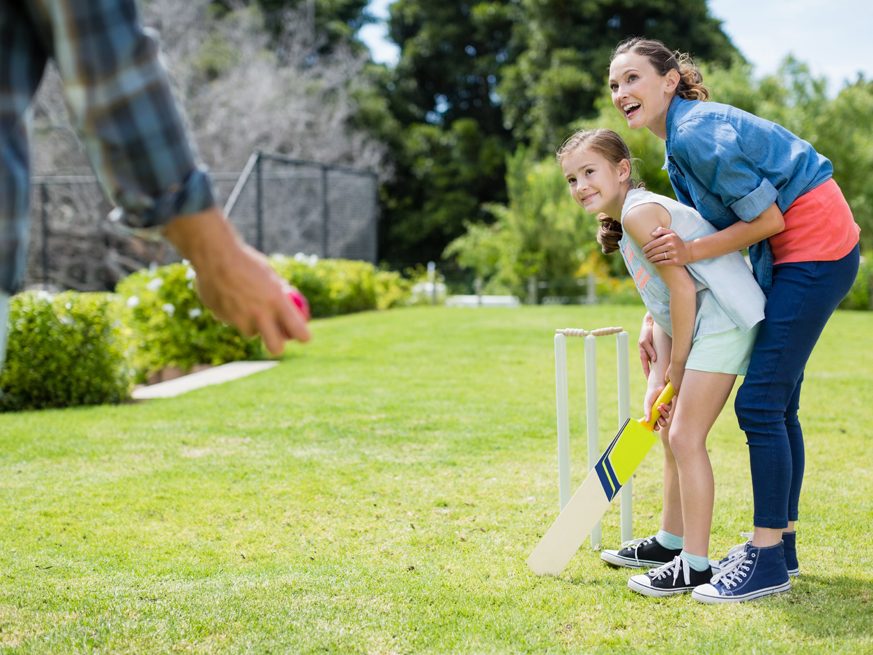Posted on: 19 October 2021
Whether you’re a cricket-mad parent or you’re just looking for a way to encourage your kids to be more active, this article will help you get your children engaged and enthusiastic about cricket, from total beginner to aspiring professional.
Cricket is a hugely beneficial sport for children to play from an early age. It teaches a great number of skills that are transferable to other facets of life, including:
- Fitness and athleticism
- Hand-eye coordination
- Depth perception
- Quick reactions
- Flexibility
- Strength
- Strategy and forward planning
- Sportsmanship
- Teamwork
- Maths and statistics
Cricket is also a great way to have fun, make friends and get involved in the local community.
As a parent, you may meet some challenges when getting your kids into cricket. Whether that’s overcoming the perception that cricket is ‘boring’, buying the right equipment, or finding a local club, the tips and advice in this article will give you a helping hand.
Start with the basics
Unless your kids already have some knowledge or experience with the sport, it’s a good idea to start with the very basics. Teach your kids the fundamental aspects of the game before progressing onto more advanced lessons.
Entry-level games such as Kwik Cricket and ‘French’ cricket can be a great introduction to the sport without piling on the pressure to play ‘properly’.
Kwik Cricket is a casual version of the game tailored for children up to the age of 11 – although it is enjoyed by players of all ages. Equipment for Kwik Cricket can be found on our website. It’s much more cost-effective than regular cricket gear, so it’s an ideal option if you’re worried about spending money on a hobby your kids might not take up. Kwik Cricket uses lightweight plastic bats and balls, so it’s much safer for younger children. It’s also easy to pack everything up to take on holiday or to the beach.
‘French’ cricket is a classic field game that involves one batter and any number of fielders. The batter stands in the centre of the field armed only with a cricket bat (you can also use a tennis racket), while all the fielders encircle them at various distances. The fielders take it in turns to throw a tennis ball (or other soft ball) at the batter, aiming below the knee. The batter must deflect the incoming ball using their bat, without moving their feet at all. If the ball is caught by a fielder without hitting the ground, the batter is out. Similarly, if a fielder manages to hit the batter’s leg below the knee with the ball, the batter is out. The fielder who got the batter out then becomes the next batter, and the batter becomes a fielder. The batter’s objective is simply to stay in as long as possible. This game teaches quick reflexes and strategy, as well as catching and throwing skills.
If you don’t fancy these, there are loads of other fun and easy bat-and-ball games you can try.
Stoke their interest
Sometimes cricket gets a bad reputation for being ‘boring’, but it’s only boring if you don’t understand what’s going on! The best way to beat this mentality, if your kids have it, is to expose them to as much exciting cricket content as possible.
There are several ways to stoke their interest in the game, including:
- Attending live matches at your local cricket ground
- Watching live matches on TV
- Listening to live commentary on Test Match Special
- Teaching your kids the rules so that they understand what’s happening
- Learning about the history of the game
- Following favourite players, their careers and playing styles
- Helping them collect players’ autographs
- Playing a cricket Top Trumps game to get them into stats and figures
There are some forms of the game that your kids may not find instantly appealing, such as 4-day county matches. However, there are now several new formats that are designed to grab children’s attention and make the game more accessible. These include T20 tournaments and newcomer The Hundred. With music, fireworks, mascots and interactive mini-games, these formats are sure to capture your child’s imagination.
If you struggle to pry your children away from their smartphones, don’t worry! There are loads of cricket apps available that might appeal to them.

Develop their techniques
If you’ve had success with some basic bat-and-ball games, it’s time to start levelling up your children’s skills. Teach them some more advanced skills, such as:
These skills can be practised in the garden or local playing field, and there are lots more video tutorials available on YouTube.
From these foundational techniques, you can begin to introduce more advanced lessons such as how to bowl spin and how to hit specific batting shots. If you’re an experienced cricketer, you may feel confident teaching your children yourself, but if you lack experience we recommend enrolling your kids at a local cricket club for juniors (see below).
Invest in some equipment
Before you look into enrolling your kids at a junior cricket club, it’s important to ensure they have the right equipment and – most crucially – that their equipment is the right size for them. Some clubs will have equipment that they loan out, but it’s always better to invest in your kids’ own gear. Correctly fitting equipment is vital not only to playing well, but also to your child’s safety.
Junior cricket bats
As you might expect, junior cricket bats are smaller and lighter than those made for adults. It’s important that your child does not attempt to play with a bat that’s too big or heavy for them, as this could result in injury.
We stock a wide range of kids’ cricket bats in all sizes.
Here’s a rough guide to junior bat sizes. Note that this is a guideline only and may not apply to your child. If in doubt, it’s always best to try out a bat in store to ensure it’s the right fit for your child.
| Bat size | Length of bat | Height of player | Age |
| 1 | 27 inches | 4 ft – 4 ft 3 in | 4-5 |
| 2 | 28 inches | 4 ft 3 in – 4 ft 6 in | 6-7 |
| 3 | 29 inches | 4 ft 6 in – 4 ft 9 in | 8 |
| 4 | 30 inches | 4 ft 9 in – 4 ft 11 in | 8-10 |
| 5 | 31 inches | 4 ft 11 in – 5 ft 2 in | 10-12 |
| 6 | 32 inches | 5 ft 2 in – 5 ft 4 in | 12-13 |
| Harrow (H) | 33 inches | 5 ft 4 in – 5 ft 8 in | 13-15 |
| Short handle (SH) | 33.5 inches | 5 ft 8 in – 6 ft 4 in | 15+ |
| Long handle (LH) | 34.5 inches | 6 ft 4 in + | 15+ |
Junior cricket sets
Just as important as the bat is the rest of the kit. Protective equipment is vital to ensure your child is safe while they play, so getting them measured up for their helmet, gloves, pads and guards is essential.
When buying a helmet, ensure you are buying a junior helmet, specifically. This is because junior cricket balls are slightly smaller than adult cricket balls, so the gap between the visor and the peak must also be smaller so as not to allow the ball to pass through. If in doubt, take a junior cricket ball and make sure it cannot fit through the gap.
We recommend replacing helmets every three years. We don’t recommend the use of second-hand helmets, as they may be damaged. If a helmet is struck significantly, it should be replaced straightaway, as the protective shell may be compromised even if no damage is visible.
All our protective gear is available in junior sizes, including boxes. (Obviously, this latter piece of equipment isn’t required for girls.)
If you have any questions about buying the right gear for your child, feel free to pop into any of our stores to talk with our friendly staff and try out the equipment we have on offer.
Find a junior cricket club
The best way to get your kids into cricket is to sign them up with a local club. Playing cricket with friends is by far the most fun aspect of the game! A blend of one-on-one tutoring and team games is the ideal way to progress young players’ abilities and enthusiasm.
The ECB runs two official cricket clubs for juniors – All Stars Cricket (for ages 5-8) and Dynamos Cricket (for ages 8-11). Thousands of clubs across the UK are subscribed to these initiatives, so it’s likely there’s one near you.
You can also find local clubs by searching these databases:
Lord’s Cricket Club runs term-time courses for children, which include age-specific group play, indoor games and one-on-one coaching.
For kids with disabilities and learning difficulties, the Lord’s Taverners offer a range of opportunities.
If your kids aren’t ready to take the game seriously yet, but still want to practice their skills, Sport4Kids have an array of casual clubs and cricket party events you can sign up for – suitable for all ages.
Finally, keep it fun!
Even if you’re a cricket-obsessed parent, you have to accept that your kids may not be as passionate about the game as you. It’s important to not be pushy when encouraging your kids into any kind of hobby – particularly a sporty one. Most children feel the need to rebel against their parents at some point in their development – so be prepared for your children to reject your attempts to get them into the game!
That said, if you always keep it fun, it will be easy to show them what a wonderful game this is, and how many benefits it can have for their lives in general. If you can do this, soon they’ll be as cricket-mad as you.
